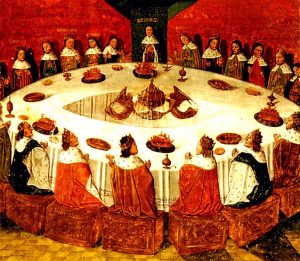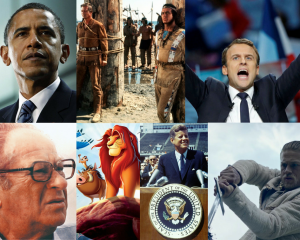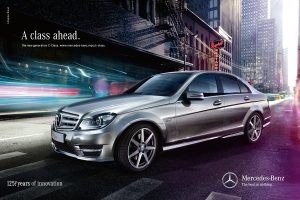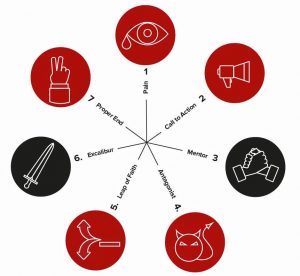These days the legend of King Arthur, as interpreted by director Guy Ritchie, is coming to the cinemas, and in Austria a young warrior is about to ascend the throne of the small kingdom of ÖVP. This reminds me of the heroes of my childhood. Besides the marine explorer and honorary chairman of the Shark Society Hans Hass and the jungle vet Daktari, these were of course Karl May's fantasy alter-egos - including Winnetou, of course - and time and again the heroic knights of the Middle Ages. These stories fascinated me to no end, I greedily devoured the books and was glued to the television in which even black and white adventure worlds came to life in all colours. What I naturally didn't understand at the time was that the effect of each of these stories usually sprang from exactly the same archaic principles.
Equally archaic were the main characters of the stories modelled. The heroes in whom I could find myself - in their hardships and their physical adventures, but even more in their behaviour, their decisions, views and insights and in their path of change, which finally led to a leap over your own shadow, with which they took the biggest hurdle towards a good end. This leap over their own shadow, with which they finally changed in an insightful way and thus only became a real hero and comprehensible role model.
Archaic narrative forms and archetypal characters have accompanied us since time immemorial, have been repackaged, interpreted and passed on again and again across cultures, lifeworlds and eras and can, indeed should, also be used for the powerful management of brands.
The origin of the legend of the mythical King Arthur/Artus appears as early as 500 AD and is often associated with the wizard Merlin as a multi-faceted mentor figure, the castle of Camelot as a metaphor for the paradisiacal ideal world and the Round Table established there as a symbol for the circle of the righteous, with the source of bliss and eternal youth, the Holy Grail, at its centre. Camelot - a paradisiacal, ideal place in a chaotic world, which in recent history is repeatedly associated with the numerous legends surrounding the White House during the presidency of John F. Kennedy.

This story is still passed on today - this time by Guy Ritchie - and is a particularly strong metaphor for a change that many people go through, or want to go through, in the course of their lives. It is the story of finding one's destiny and thus one's own roots, of accepting the call of the inner voice and the transformation of a person from Young Warrior to King. In the end, this change also means growing up.
In real life, this change can currently be observed footloose in Austria. For many, the young, combative Foreign Minister Sebastian Kurz, archaic young warrior, is a real shining light in the midst of a completely intricate political unculture, similar to Emmanuel Macron or Barack Obama. The bearer of hope, who has already transformed himself once, from a young politician who was not taken seriously at all and mocked as a young whippersnapper to the pacesetter of European refugee policy, is currently making the epic leap to the top of his party. And thus, once again, in transition: to king.

What distinguishes the king from a warrior or a ruler is his responsibility for the big picture. And very importantly, for a King character to have a positive effect, he stands for protection and justice and is by no means an oppressor of his subjects. On the contrary: he is the guarantor of their well-being, their security, of a future that will be better than today.
If we transfer these characteristics to the world of brand personalities, this can be a particularly strong profile that has a magnetic effect on many people and, used correctly, becomes an unbeatable model for success. Probably the best example of such an archetypal King brand personalityis Mercedes.

These are the structural facets of a King characterthat, in varying degrees, paint the image of the brand and are emphasised in conversation with the audience and can thus form the basis for a strong, sustainable brand story.
(Market) leadership position
Take responsibility offensively - market leaders are topic leaders!
Provides structure and order in chaos and handles complex situations with confidence.
Uses his power and influence positively to make the world a better place.
Self-confident, competent, reliable.
Motivates others to achieve high goals.
Is a role model for others.
Mediates between opposing parties and makes peace.
BUT BEWARE: King characters can also come across as overly dominant, something brands should not do under any circumstances, because times have changed. It is not the brand that is the hero, but the people who have to become the hero through the brand. Therefore, when managing your brand, you must not only bring the character, i.e. the personality of your brand, to life, but it is imperative that you know the role of the brand in history.

The role of the brand in the brand story is undoubtedly not that of the hero, but that of the supporting mentor. Our method Hero Branding® - Brands make Heroes is based on this principle of changing perspectives.

From Arthurian legend, we have used Excalibur as a metaphor for the product in the relationship between brand and audience. Excalibur, is one of the first branded products in history, because this sword does exactly what effective branded products must do. They are excellent as a product and deliver a special added value to the user: they transform him or her into a respected king, a queen, through use, thus delivering the all-important emotional added value, the meaning.
Picture references:
Round Table | Winnetou | Short Europe| Kennedy | Kreisky | Macron | Sword
